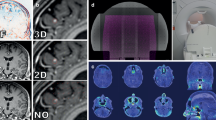Abstract
This study elucidated the effects of a three-dimensional k-space trajectory incorporating the partial Fourier (PF) technique on a time–intensity curve (TIC) in a dynamic contrast-enhanced magnetic resonance imaging of a typical malignant breast tumor using a digital phantom. Images were obtained from the Cancer Imaging Archive Open Data for Breast Cancer, and 1-min scans with high temporal resolution were analyzed. The order of the k-space trajectory was set as Linear (sequential), Low–High (centric), PF (62.5%; Z-, Y-, and both directions), and Low–High Radial. k0 (center of the k-space) timing and TIC shape were affected by the chosen k-space trajectory and implementation of the PF technique. A small TIC gradient was obtained using a Low–High Radial order. If the k-space filling method (particularly the radial method) produces a gentle TIC gradient, misinterpretation could arise during the assessment of tumor malignancy status.







Similar content being viewed by others
References
American College of Radiology. Breast imaging reporting and data system (BI-RADS). 5th edn. Reston, VA: American College of Radiology; 2013.
Kuhl CK, Mielcareck P, Klaschik S, Leutner C, Wardelmann E, Gieseke J, Schilid HH. Dynamic breast MR imaging: are signal intensity time course data useful for differential diagnosis of enhancing lesion? Radiology. 1999;211:101–10.
Moate PJ, Dougherty L, Schnall MD, Landis RJ, Boston RC. A modified logistic model to describe gadolinium kinetics in breast tumors. Magn Reson Imaging. 2004;22:467–73.
Mann RM, Kuhl CK, Kinkel K, Boetes C. Breast MRI: guidelines from the European Society of Breast Imaging. Eur Radiol. 2008;18:1307–18.
Kuhl C. The current status of breast MR imaging. Part I. Choice of technique, image interpretation, diagnostic accuracy, and transfer to clinical practice. Radiology. 2007;244: 356–78.
King KF. Chapter 11.2, k-space, chapter 11.3, keyhole, BRISK, and TRICKS. In: Bernstein MA, King KF, Zhou XJ, editors. Handbook of MRI pulse sequences. London: Elsevier Academic Press; 2004. p. 378–93.
Zhou XJ. Chapter 11.5, two-dimensional acquisition. In: Bernstein MA, King KF, Zhou XJ, editors. Handbook of MRI pulse sequences. London: Elsevier Academic Press; 2004. p. 405–23.
King KF. Chapter 17.5, projection acquition. In: Bernstein MA, King KF, Zhou XJ, editors. Handbook of MRI pulse sequences. London: Elsevier Academic Press; 2004. p. 897–927.
Sekine T, Amano Y, Takagi R, Matsumura Y, Murai Y, Kumita S. Feasibility of 4D flow MR imaging of brain with either Cartesian y-z radial sampling or k-t SENSE: comparison with 4D flow MR imaging using SENSE. Magn Reason Med Sci. 2014;13:15–24.
Feng L, Grimm R, Block KT, Chandarana H, Kim S, Xu J, Axel L, Sodickson DK, Otazo R. Golden-angle radial sparse parallel MRI: combination of compressed sensing, parallel imaging, and golden-angle radial sampling for fast and flexible dynamic volumetric MRI. Magn Reson Med. 2014;72:707–17.
Takatsu Y, Ueyama T, Iwasaki T, Asahara M, Honda M, Miyati T. Effects of k-space orders on the time-intensity curves in dynamic contrast-enhanced magnetic resonance imaging of the breast based on simulation study. Magn Reson Imaging. 2021;79:85–96.
Takatsu Y, Ueyama T, Miyati T, Yamamura K. Simulation of the modulation transfer function dependent on the partial Fourier fraction in dynamic contrast enhancement magnetic resonance imaging. Australas Phys Eng Sci Med. 2016;39:825–31.
King KF, Chap 13.4, partial Fourier reconstruction. In: Bernstein MA, King KF, Zhou XJ, editors. Handbook of MRI pulse sequences. London: Elsevier Academic Press; 2004. p. 546–58.
Kazerooni AF, Nabil M, Khah HH, Parviz S, Gity M, Rad HS. A one-step biomarker quantification methodology for DCE-MRI of adnexal masses: capturing kinetic pattern from early to late enhancement. Magn Reson Med. 2018;79:1165–71.
King KF. Chapter 13.2, k-space, gridding reconstruction. In: Bernstein MA, King KF, Zhou XJ, editors. Handbook of MRI pulse sequences. London: Elsevier Academic Press; 2004. p. 506–21.
Mann RM, Cho N, Moy L. Breast MRI: state of the art. Radiology. 2019;292:520–36.
MathWorks Help Center. In: Evaluating goodness of fit. The MathWorks, Inc. 1994–2023. Accessed 25 Dec 2023.
King KF, Chap 13.1, Fourier reconstruction. In: Bernstein MA, King KF, Zhou XJ, editors. Handbook of MRI pulse sequences. London: Elsevier Academic Press; 2004. p. 491–505.
Dang Y, Guo L, Lv D, Wang X, Zhang J. Classification of breast lesions based on a dual S-shaped logistic model in dynamic contrast enhanced magnetic resonance imaging. Sci China Life Sci. 2011;54:889–96.
Acknowledgements
The authors would like to thank Dr. Kenichiro Yamamura of Tokushima Bunri University for his valuable advice and technical support during the measurements.
Funding
No funds, grants, or other support was received. The authors declare they have no financial interests.
Author information
Authors and Affiliations
Corresponding author
Ethics declarations
Conflict of interests
The authors have no competing interests to declare relevant to the content of this article.
Ethics approval
A digital phantom study was conducted using online images. Therefore, approval from the Institutional Review Board was not required.
Informed consent
Not applicable.
Additional information
Publisher's Note
Springer Nature remains neutral with regard to jurisdictional claims in published maps and institutional affiliations.
About this article
Cite this article
Takatsu, Y., Ueyama, T., Iwasaki, T. et al. Simulation of time–intensity curve based on k-space filling in breast dynamic contrast-enhanced three-dimensional magnetic resonance imaging. Radiol Phys Technol (2024). https://doi.org/10.1007/s12194-024-00793-y
Received:
Revised:
Accepted:
Published:
DOI: https://doi.org/10.1007/s12194-024-00793-y




